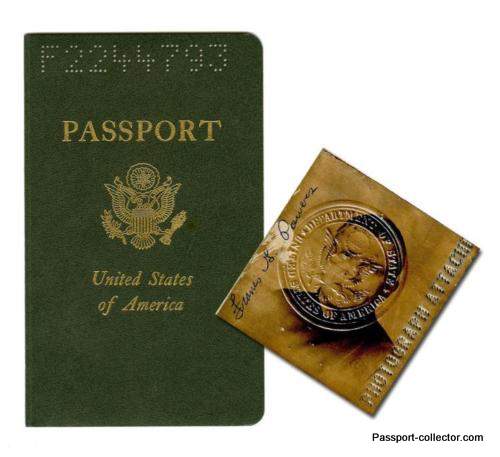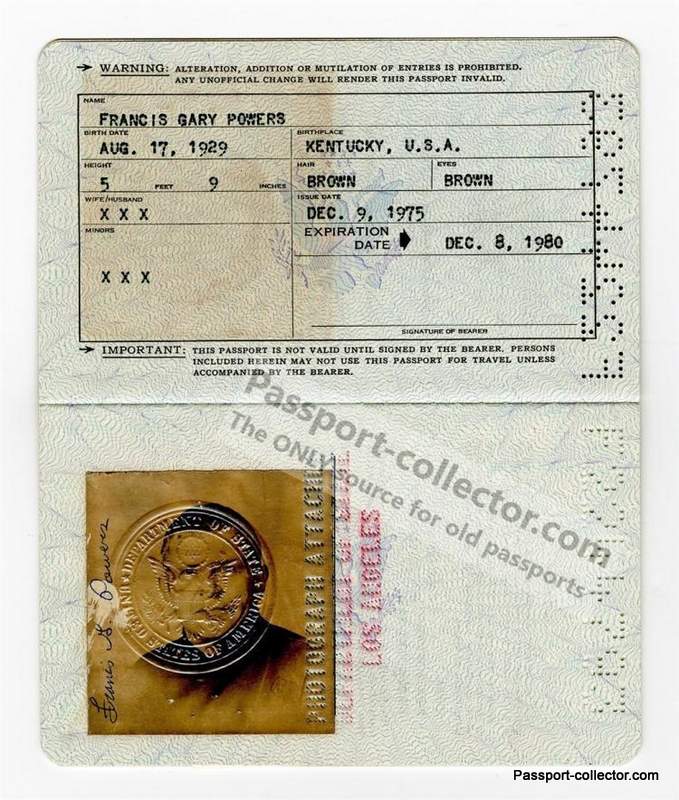Francis Gary Powers passport – the real-life Bridge of Spies
Francis Gary Powers passport
Francis Gary Powers
A United States of America passport belonging to Francis Gary Powers, issued on December 9, 1975, includes a photograph of Powers and is signed “Francis G Powers” in blue ink on the photo. The cover, a leather-grained green vinyl, is stamped with the United States Seal in gilt. The passport comes with impeccable provenance directly by Mr. Powers’ son, Francis Gary Powers Jr., via auction. Francis Gary Powers Jr. became an expert public speaker on the U-2 Incident and Cold War History. Accompanied by a Letter of Provenance by Francis Gary Powers, Jr, stating the passport was the property of Francis Gary Powers and came directly from Mr. Powers’ son.

More than just a CIA pilot, Francis Gary Powers considered himself first and foremost a pilot. At just 30 years old, he loved flying and was an incredibly experienced U-2 pilot, having flown more flights than anyone else in the program. His passport was his ticket to worldwide travel and discovery. Unfortunately, as can be seen, by the pages of this passport, unmarked by foreign stamps, Powers never managed to use this passport. He died in a helicopter accident over LA shortly after this passport was issued. Francis Gary Powers passport

Powers’ incredible story took place in the early beginning of the Cold War and during the creation of the Berlin wall (1961). This phenomenal period in history was wonderfully depicted in Steven Spielberg’s classic “The Bridge Of Spies” in which the full ambiance of the cold period, the poverty, the fear, the governmental oppression, and the building of the Berlin Wall allowed the viewer to perhaps more fully comprehend this incredible era and put Power’s CIA mission into perspective. Francis Gary Powers passport
His story is shown in more detail below:
Graduating college in June 1950, Gary enlisted in the Air Force in October. He was commissioned in the US Air Force in December 1952 after completing his advanced training with USAF Pilot Training Class 52-H. By January 1956, he was recruited by the CIA. Francis Gary Powers passport
Upon joining the CIA’s U-2 program at the civilian grade of GS-12, Powers flew espionage missions at altitudes above 70,000 feet (21 km), well above the reach of Soviet air defenses. The U-2 was equipped with a state-of-the-art camera designed to take high-resolution photos from the edge of the stratosphere over hostile countries, including the Soviet Union. U-2 missions systematically photographed military installations and other important sites. Francis Gary Powers passport
Spy mission
The primary mission of the U-2s was overflying Russia. The border surveillance and atomic sampling, though vital, were secondary.” Additionally, the U-2 flew “special missions.” Beginning on September 27, 1956, and continuing until 1960. “The United States was spying not only on most of the countries in the Middle East but also on her own allies.” Soviet intelligence had been aware of encroaching U-2 flights at least since 1958, if not sooner but lacked effective countermeasures until 1960. On May 1, 1960, Powers’ U-2A was the first attempt “to fly all the way across the Soviet Union…but it was considered worth the gamble. The planned route would take us deeper into Russia than we had ever gone while traversing important targets never before photographed.”

Shot down
A surface-to-air missile shot powers down during a mission. The Soviets sent a Mig-19 jet fighter to intercept the Power’s aircraft but could not reach a high enough altitude. Its pilot ejected but died of his injuries. Another Soviet aircraft also attempted to intercept Powers’ U-2. The unarmed Su-9 was directed to ram the U-2 but missed because of the large differences in speed (the Su-9 flew above Mach 1.1, while the U-2 flew at approximately Mach 0.6). Francis Gary Powers passport
The first of three SA-2 Guideline (S-75 Dvina) surface-to-air missiles launched at the U-2 near Kosulino in the Ural Region impacted the aircraft. “What was left of the plane began spinning, only upside down, the nose pointing upward toward the sky, the tail down toward the ground.” Powers could not activate the plane’s self-destruct mechanism before being thrown out of the plane after releasing the canopy and his seat belt. While descending under his parachute, Powers had time to scatter his escape map and rid himself of part of his suicide device, a silver dollar coin suspended around his neck containing a poison-laced injection pin, though he kept the poison pin. “Yet I was still hopeful of escape.” He hit the ground hard, was immediately captured, and taken to prison in Moscow. (He was originally criticized for not committing suicide by taking the poison … a CIA concern which was later retracted).
The incident set back talks between Khrushchev and Eisenhower. Powers’ interrogations ended on June 30, and his solitary confinement on July 9. On August 17, 1960, his trial for espionage began before the military division of the Supreme Court of the USSR. On August 19, 1960, Powers was convicted of espionage, “a grave crime covered by Article 2 of the Soviet Union’s law ‘On Criminality Responsibility for State Crimes'”. His sentence consisted of ten years of confinement, three of which were in prison, with the remainder in a labor camp. ACCORDING TO POWERS, the US Embassy “News Bulletin” stated, “as far as the government was concerned, I had acted by the instructions given me and would receive my full salary while imprisoned Francis Gary Powers passport.”
He was held in Vladimir Prison from September 9, 1960, until February 8, 1962. Gary kept a diary and a journal while confined. Additionally, he took up carpet weaving from his cellmate to pass the time. He could send and receive a limited number of letters from his family. The prison now contains a small museum with Powers exhibit, which allegedly developed a good rapport with Russian prisoners.
Death
On August 1, 1977, while conducting a traffic report over Los Angeles, his helicopter crashed, killing him and George Spears, his cameraman. Powers covered brush fires in Santa Barbara County in the KNBC helicopter and headed back from flying over them.
In 1998, newly declassified information revealed that Powers’s mission had been a joint USAF/CIA operation. In 2000, on the 40th anniversary of the U-2 Incident, his family was presented with his posthumously awarded Prisoner of War Medal, Distinguished Flying Cross, and National Defense Service Medal. In addition, CIA Director authorized Powers to posthumously receive the CIA’s coveted Director’s Medal for extreme fidelity and extraordinary courage in the line of duty. Francis Gary Powers passport
FAQ Passport History
Passport collection, passport renewal, old passports for sale, vintage passport, emergency passport renewal, same day passport, passport application, pasaporte passeport паспорт 护照 パスポート جواز سفر पासपोर्ट
1. What are the earliest known examples of passports, and how have they evolved?
The word "passport" came up only in the mid 15th Century. Before that, such documents were safe conducts, recommendations or protection letters. On a practical aspect, the earliest passport I have seen was from the mid 16th Century. Read more...
2. Are there any notable historical figures or personalities whose passports are highly sought after by collectors?
Every collector is doing well to define his collection focus, and yes, there are collectors looking for Celebrity passports and travel documents of historical figures like Winston Churchill, Brothers Grimm, Johann Wolfgang von Goethe. Read more...
3. How did passport designs and security features change throughout different periods in history, and what impact did these changes have on forgery prevention?
"Passports" before the 18th Century had a pure functional character. Security features were, in the best case, a watermark and a wax seal. Forgery, back then, was not an issue like it is nowadays. Only from the 1980s on, security features became a thing. A state-of-the-art passport nowadays has dozens of security features - visible and invisible. Some are known only by the security document printer itself. Read more...
4. What are some of the rarest and most valuable historical passports that have ever been sold or auctioned?
Lou Gehrig, Victor Tsoi, Marilyn Monroe, James Joyce, and Albert Einstein when it comes to the most expensive ones. Read more...
5. How do diplomatic passports differ from regular passports, and what makes them significant to collectors?
Such documents were often held by officials in high ranks, like ambassadors, consuls or special envoys. Furthermore, these travel documents are often frequently traveled. Hence, they hold a tapestry of stamps or visas. Partly from unusual places.
6. Can you provide insights into the stories behind specific historical passports that offer unique insights into past travel and migration trends?
A passport tells the story of its bearer and these stories can be everything - surprising, sad, vivid. Isabella Bird and her travels (1831-1904) or Mary Kingsley, a fearless Lady explorer.
7. What role did passports play during significant historical events, such as wartime travel restrictions or international treaties?
During war, a passport could have been a matter of life or death. Especially, when we are looking into WWII and the Holocaust. And yes, during that time, passports and similar documents were often forged to escape and save lives. Example...
8. How has the emergence of digital passports and biometric identification impacted the world of passport collecting?
Current modern passports having now often a sparkling, flashy design. This has mainly two reasons. 1. Improved security and 2. Displaying a countries' heritage, icons, and important figures or achievements. I can fully understand that those modern documents are wanted, especially by younger collectors.
9. Are there any specialized collections of passports, such as those from a specific country, era, or distinguished individuals?
Yes, the University of Western Sidney Library has e.g. a passport collection of the former prime minister Hon Edward Gough Whitlam and his wife Margaret. They are all diplomatic passports and I had the pleasure to apprise them. I hold e.g. a collection of almost all types of the German Empire passports (only 2 types are still missing). Also, my East German passport collection is quite extensive with pretty rare passport types.
10. Where can passport collectors find reliable resources and reputable sellers to expand their collection and learn more about passport history?
A good start is eBay, Delcampe, flea markets, garage or estate sales. The more significant travel documents you probably find at the classic auction houses. Sometimes I also offer documents from my archive/collection. See offers... As you are already here, you surely found a great source on the topic 😉
Other great sources are: Scottish Passports, The Nansen passport, The secret lives of diplomatic couriers
11. Is vintage passport collecting legal? What are the regulations and considerations collectors should know when acquiring historical passports?
First, it's important to stress that each country has its own laws when it comes to passports. Collecting old vintage passports for historical or educational reasons is safe and legal, or at least tolerated. More details on the legal aspects are here...
Does this article spark your curiosity about passport collecting and the history of passports? With this valuable information, you have a good basis to start your own passport collection.
Question? Contact me...

